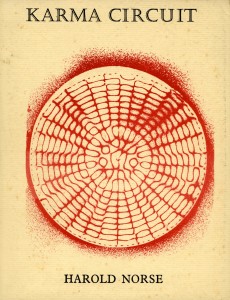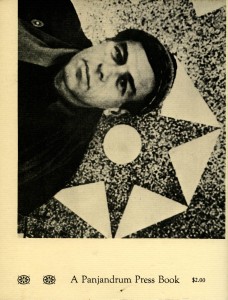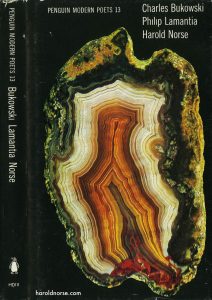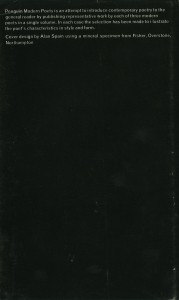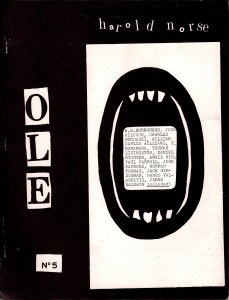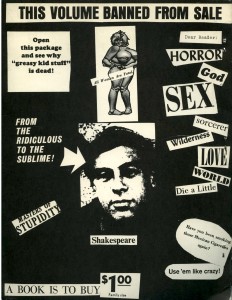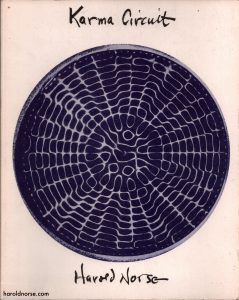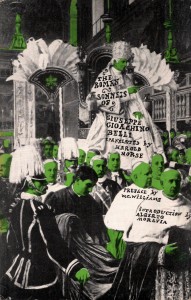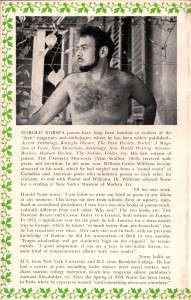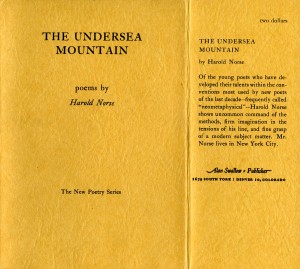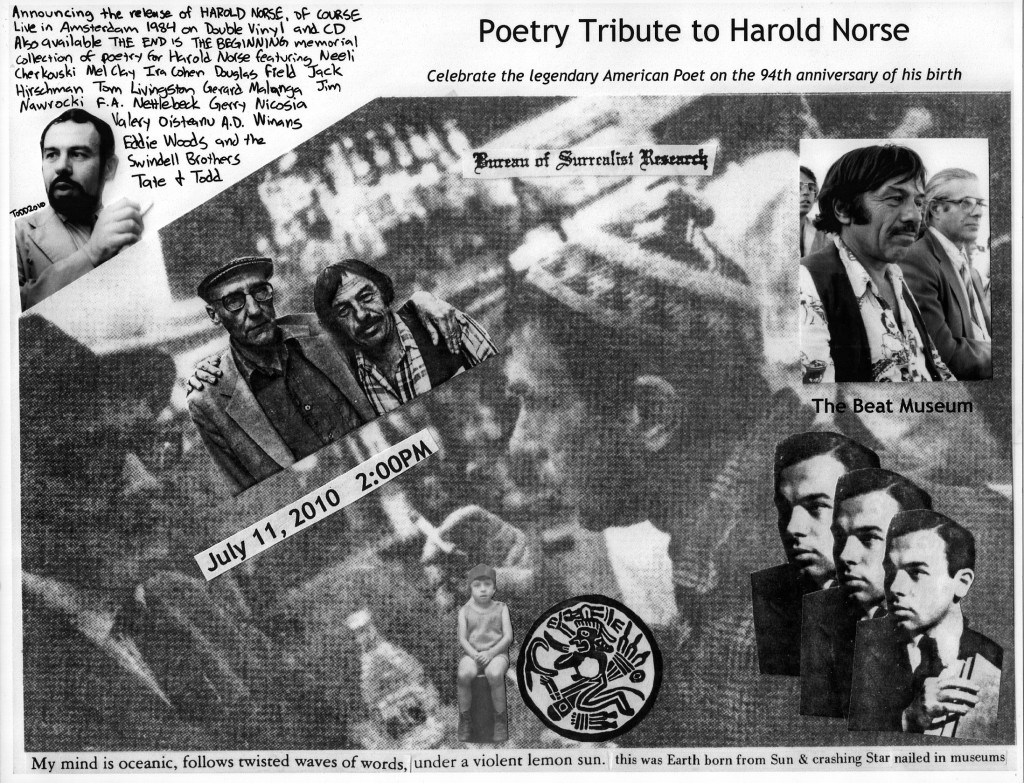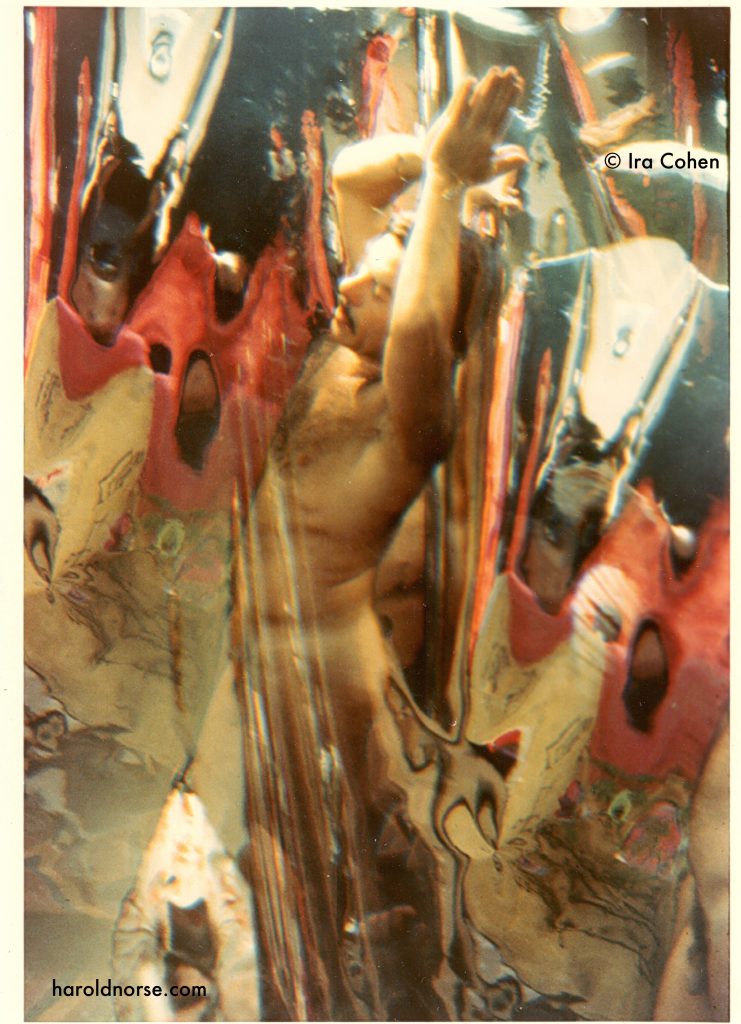Karma Circuit, San Francisco, Back Cover
Penguin Modern Poets 13, with Charles Bukowski and Philip Lamantia, Harmondsworth: Penguin, 1969
Penguin Modern Poets 13, Back Cover
Olé, No. 5, San Francisco: Open Skull Press, 1966
Olé, No. 5, Back Cover
Karma Circuit, London: Nothing Doing in London, 1966
Karma Circuit, London, Back Cover
The Dancing Beasts, New York: Macmillan, 1962
The Dancing Beasts, Back Cover
The Roman Sonnets of Giuseppe Gioacchino Belli, Jargon 38, 1960
The Roman Sonnets of Giuseppe Gioacchino Belli, Back Cover
The Undersea Mountain, Denver: Swallow Press, 1953
The Undersea Mountain, Back Cover
We Salute Ira Cohen- Poet, Photographer, Film Maker and Magician
 Ira Cohen first met Harold in Tangier in the early 1960s when they were part of an expatriate group that included William Burroughs and Paul Bowles. It was Ira who gave the title “Sniffing Keyholes” to Harold’s first cut-up piece which was first published in Ira’s magazine GNAOUA, subsequently featured by Bob Dylan on the cover of Bringing It All Back Home.
Ira Cohen first met Harold in Tangier in the early 1960s when they were part of an expatriate group that included William Burroughs and Paul Bowles. It was Ira who gave the title “Sniffing Keyholes” to Harold’s first cut-up piece which was first published in Ira’s magazine GNAOUA, subsequently featured by Bob Dylan on the cover of Bringing It All Back Home.
Harold paid a visit to Ira’s Mylar Chamber while in New York City in the Summer of 1970. The photographs captured Harold dancing as a psychedelic Krishna, naked, flashing mudras. A photo from this series was featured, albeit in black and white, on the cover of Carnivorous Saint, Harold’s seminal collection of gay poetry .
Along with Judith Malina and the late Charles Henri Ford, Ira Cohen remained a loving friend until the end of Harold’s life. After Harold moved into an assisted-care facility, I remember Ira telling me on the phone that he wanted to cheer Harold up by sending him sweet potato pies and fudgesicles in the mail.
In 2007 when Ira made his last visit to San Francisco, he made sure to pay a visit to Harold. Sitting across from each other in Harold’s cramped room, they made quite a pair. Talk turned to reminiscence of Burroughs and the Beat Hotel. Harold, whose memory had begun to fail him, turned to Ira and asked, “Do you know Ira Cohen?” Without missing a beat, Ira replied brightly, “That’s me!” Harold was so pleased. He said, “How wonderful,” as he leaned over to shake Ira’s hand.
Being slips in and out of time’s stream of thought and memory.
Gone but not forgotten. Still here, more than most.
Image and word continue on, guiding us, chiding us, inspiring us.
Poetry Tribute to Harold Norse – July 11, 2010
We Salute Peter Orlovsky- Poet, Farmer and Queer Revolutionary
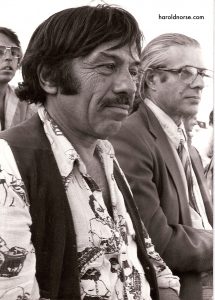 Harold Norse and Peter Orlovsky at Naropa Institute, July 1980. Photograph by Michael Kellner.
Harold Norse and Peter Orlovsky at Naropa Institute, July 1980. Photograph by Michael Kellner.
In the summer of 1980, Harold joined Burroughs, Ginsberg and Peter Orlovsky for a joint reading at Naropa Institute where Peter had taught poetry the previous decade.
Peter Orlovsky, poet, Ginsberg’s partner, dies
Julian Guthrie, Chronicle Staff Writer
Thursday, June 3, 2010
Peter Orlovsky was a sweet and handsome 21-year-old with a troubled past when he met Allen Ginsberg in San Francisco in 1954, and the two forged a relationship that would last for decades and transform their lives.
Mr. Orlovsky, who became a poet in his own right but was always overshadowed by Ginsberg’s fame, died Sunday in Vermont. He was 76 and had battled emphysema and lung cancer.
“When Peter and Allen met, they were both troubled,” said Gerald Nicosia, a Marin County poet and biographer of Jack Kerouac. “Ginsberg was troubled by his homosexuality and afraid to be a poet, and Peter had come from this family defined by mental illness, and he was living in San Francisco and wondering where his own life was going.”
Within a year of meeting Mr. Orlovsky, Ginsberg started writing “Howl,” a poem that was first performed Oct. 7, 1955, at the Six Gallery in San Francisco and published a year later. The controversial poem became a seminal work of the Beat Generation.
“Allen was the brains, and Peter was the heart,” said Nicosia. ” You couldn’t be around him without feeling this love radiating from his eyes.”
With Ginsberg’s encouragement, Mr. Orlovsky, who had been born into poverty, grown up in a converted chicken coop on Long Island and seen his siblings institutionalized, began keeping a journal and writing poems.
Mr. Orlovsky could also be a natural performer, pausing from poetry recitations to break into a yodel, wearing outrageous clothes and growing a ponytail that ran down his back. He also was known for trying to get the hard-partying beat poets of his generation to eat more fruits and vegetables.
Ginsberg and Mr. Orlovsky were notorious early in their relationship for taking off all their clothes at Bay Area parties, and were sometimes invited to parties just for that.
In 1974, Mr. Orlovsky began teaching poetry at the Naropa Institute in Boulder, Colo., and in 1979 he received a grant from the National Endowment for the Arts. City Lights Books in North Beach collected Mr. Orlovsky’s works. In 1980, Gay Sunshine Press published “Straight Hearts’ Delight,” comprised of the letters and love poems between Mr. Orlovsky and Ginsberg.
Over the years, they became one of the most famous openly gay couples – with Mr. Orlovsky listed in “Who’s Who” as Ginsberg’s “wife.” They split as a couple in the late 1980s, when Mr. Orlovsky had a mental breakdown, but remained close.
Ginsberg died in 1997. Mr. Orlovsky was said to have started in recent years working on his memoir.
E-mail Julian Guthrie at jguthrie@sfchronicle.com.
This article appeared on page C – 5 of the San Francisco Chronicle
To Mohammed on Our Journeys
I was the tourist
el simpático
and your brother offered you
and almost himself
I forgot about your brother
and we took a flat in the Marshan
with reed mats and one water tap
about a foot from the floor
an we smoked hasheesh
and ate well and loved well
and left for the south
Essaouira, Fez, Marrakech
and got to Taroudant
thru the mountains
and bought alabaster kif bowls
for a few dirharms and watched
the dancing boys in desert cafés
kissing old Arabs and sitting on their
laps, dancing with kohl eyes
and heard the music in Jejouka
in the hills under the stars
the ancient ceremony, Pan pipes
fierce in the white moonlight
by white walls
with hooded figures
stoned on kif
for eight nights
and the goat boy in a floppy hat
scared us,beating the air
with a stick, beating whoever came close,
Father of Skins, goat god,
and the flutes maddened us
and we slept together in huts
Carnivorous Saint Cover Photo Shoot 1970
Guardian UK Obituary
Striking Beat writer and artist later feted as one of America’s leading gay poets
By Douglas Field
The Guardian, Wednesday, June 17, 2009
William Carlos Williams once wrote to Harold Norse, who has died aged 92, that “you are the best poet of your generation”. Often associated with the Beat writers, Norse began publishing in the early 1940s, befriending and collaborating with leading 20th-century literary figures, among them WH Auden, James Baldwin and Allen Ginsberg. The author of 12 books of poetry, Norse was nominated for the US National Book award in 1974, but never achieved the success of his more celebrated peers.
Born Harold Rosen (a surname he later rearranged into “Norse”), he grew up in a poor Brooklyn neighbourhood in New York. His mother, an illiterate Lithuanian immigrant, had lost touch with his father by the time her only son was born. In 1938 he earned a bachelor’s degree at Brooklyn College where, the following year, he and Chester Kallman, his boyfriend, winked at Auden at a poetry reading. Kallman and Auden became lovers and Norse worked briefly as the poet’s secretary. Remaining in Auden’s circle for some years, by the early 1940s Norse was something of a literary Leonard Zelig, blending in and out of artistic circles.
A talented writer in his own right, he cultivated an extraordinary number of relationships, both personal and professional. In the early 1940s Norse met Ginsberg on the subway in Manhattan and became friends with Baldwin in Greenwich Village. He also spent a summer with Tennessee Williams as the playwright put the finishing touches to The Glass Menagerie, and survived drinking sessions with Dylan Thomas in 1950. He was awarded his master’s degree at New York University the following year.
Norse then met William Carlos Williams, who encouraged him to break free from academic poetry and write in his native Brooklyn tongue. Williams had a profound effect on Norse’s poetic voice and career, which is captured in American Idiom (1990), a record of their decade-long correspondence, beginning in 1951. After collaborating with Julian Beck and Judith Malina on what would become the experimental theatre group Living Theatre (notable for staging the works of American poets), Norse began publishing in literary magazines including Poetry and Saturday Review. His first collection, The Undersea Mountain, was published in 1953.
Despite his initial success, Norse remained frustrated with the New York poetry scene, which was dominated by the influence of Ezra Pound and TS Eliot. Heading abroad in search of literary and sexual freedom, Norse spent 15 years in Europe and North Africa. In Italy he translated the sonnets of GG Belli; these were published in 1960 as The Roman Sonnets of GG Belli, with the Roman’s dialect poetry transformed into bawdy Brooklynese.
Between 1960 and 1963 Norse lived in Paris with William Burroughs, Ginsberg and Gregory Corso in the hotel in the Latin Quarter known as the “Beat Hotel”. Although initially wary of the Beat writers’ literary credentials, Norse collaborated with Brion Gysin on the cut-up technique and was briefly an acclaimed painter of ink drawings soaked in the hotel bidet, known as Cosmographs. After travelling to Greece (where he met Leonard Cohen) and north Africa (where he struck up a friendship with Paul Bowles), Norse returned to the US, settling in California. There he became friends with the writer Charles Bukowski and began bodybuilding with Arnold Schwarzenegger, then an unknown.
Norse’s move to San Francisco in 1972 resulted in a productive spell. In 1974 City Lights, the publisher and bookshop founded by Lawrence Ferlinghetti, released Hotel Nirvana, Selected Poems, 1953-1973, to critical acclaim. After the publication of Carnivorous Saint: Gay Poems, 1941-1976, Norse was feted as one of America’s leading gay poets. This was followed by Harold Norse: The Love Poems, 1940-1985, and his final volume, In the Hub of the Fiery Force: Collected Poems, 1934-2003. His autobiography, Memoirs of a Bastard Angel: a Fifty Year Literary and Erotic Odyssey, was published in 1989.
Although Norse received support and acclaim from writers including Anaïs Nin, Burroughs and Bukowski, his work did not bring him the financial rewards or literary acclaim that he craved. Norse described himself as a “lone-wolf” and he refused to join the pack, at some cost. In many ways he was more “Beat” than the Beats: Jewish, illegitimate, homosexual, Norse was an outsider who quietly produced some startling and technically accomplished verse from the fringes of the US literary scene.
His return to America as the gay liberation movement gathered momentum gave Norse’s poetry a new sense of coherence and direction that critics had failed to spot. He wrote pioneering poems about masculinity (I Am Not a Man) and achingly painful snapshots of loneliness and unrequited love. In later years he reflected on what it meant to be an older gay poet in San Francisco, captured in the poem Old Age Does Not Happen Slowly, which ends, “If you’re gay you’re dead.”
Towards the end of his life Norse was surrounded by a group of friends who looked after him. When I interviewed him in 2007, it was clear his lack of recognition disappointed him. It was a theme that resurfaced as he pondered on his age: “I’m not a poet any more. I’m an old man.” But such moments rarely lasted, as Norse reminisced: “I have never felt I was any worth and I had to write and write and write.”
Flirtatious but gentlemanly, Norse could shock but did not want to offend. “You could be a real knockout,” he told me when we met, “if only you dressed better.” Full of Brooklyn wisecracks (“I can imitate anyone – even myself”), he was still reading his poetry at the age of 91 to enthralled audiences.
His 1958 poem Classic Frieze in a Garage captures the joy of unexpectedly spotting a frieze in Naples “amongst the greasy rags/ and wheels & axles of a garage”, a prophetic comment on the misplacing of his own best work.
• Harold Norse (Harold Rosen), poet, born 6 July 1916; died 8 June 2009

